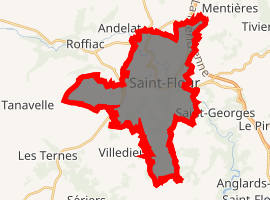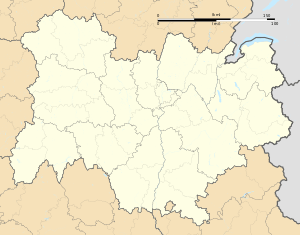Saint-Flour, Cantal
Saint-Flour (French: [sɛ̃fluʁ]; Auvergnat: Sant Flor) is a commune in the Cantal department in the Auvergne region in south-central France, around 101 km south of Clermont-Ferrand. Its inhabitants are called Sanflorains.
Saint-Flour | |
|---|---|
Subprefecture and commune | |
 A general view of Saint-Flour | |
.svg.png) Coat of arms | |
Location of Saint-Flour 
| |
 Saint-Flour  Saint-Flour | |
| Coordinates: 45°02′04″N 3°05′37″E | |
| Country | France |
| Region | Auvergne-Rhône-Alpes |
| Department | Cantal |
| Arrondissement | Saint-Flour |
| Canton | Saint-Flour-1 and 2 |
| Government | |
| • Mayor (2008–2014) | Pierre Jarlier (PR) |
| Area 1 | 27.14 km2 (10.48 sq mi) |
| Population (2017-01-01)[1] | 6,435 |
| • Density | 240/km2 (610/sq mi) |
| Time zone | UTC+01:00 (CET) |
| • Summer (DST) | UTC+02:00 (CEST) |
| INSEE/Postal code | 15187 /15100 |
| Elevation | 757–1,040 m (2,484–3,412 ft) (avg. 783 m or 2,569 ft) |
| 1 French Land Register data, which excludes lakes, ponds, glaciers > 1 km2 (0.386 sq mi or 247 acres) and river estuaries. | |
Geography
The upper city (ville haute) of Saint-Flour is located on the abrupt volcanic dike Planèze, the lower city (ville basse or "Faubourg") extends on the banks of the Ander.
History
There are numerous dolmens in the neighborhood[2] and scattered traces of Bronze Age occupation. Roman occupation is signalled by two Roman villas of middling importance, one near the railroad station, the other a modest Augustan-age villa near the hamlet of Roueyre, part of Saint-Flour. The Roman name of this small vicus was Indiciacum or Indiciacus, which evolved into Indiciat in the sub-Roman period, a reference to the landmark of Planèze.
Middle Ages
Early, perhaps as early as the fifth century,[3] Florus of Lodève, credited in medieval tradition with being the first bishop of Lodève and belonging to the apostolic era,[4] arrived to Christianize the valley, and gave his name to the area, striking a rock with his staff, it was said, to create a holy spring that continued to be venerated under its Christianized guise, into the 20th century.[5]
The present town called Indiciac took shape only around the millennium, clustered around the monastery founded on the high rock in 996, at first little more than an oratory. The site, already occupied by a small monastic community, was donated to Odilo of Cluny by the Auvergnat seigneur, Astorg de Brezons;[6] the donation was confirmed by Pope Gregory V, i.e. in 996-99, but Astorg's nephew, Amblard "le mal Hiverné" ("the furious"), the comptour[7] perhaps asserting residual family interests in the place, seized it and laid it waste, sparing the church. Astorg and Amblard together then donated it to St Peter's, but Amblard reconsidered and erected a fortress in the ruins of the monastery, but, seized with remorse, donated it once more to Odilo of Cluny.[8] Urban II, following the Council of Clermont (1095) consecrated the new abbey church, which received a triple dedication reflecting local tradition and present affiliations: Saint-Sauveur, Saint Pierre and Saint Flour.[9]
The diocese of Saint-Flour was established in August 1317 by the Avignon pope, John XXII.
French Revolution
During the Revolution the commune took several successive names, de-Christianized as Fort-Cantal, Fort-Libre then Mont-Flour before retrieving its ancient historic designation in an II (1793). The territory of the commune was never changed. Briefly, between 1790 and 1795 it served as the préfecture of the newly created département, before Aurillac succeeded to that position.
Personalities
| Year | Pop. | ±% |
|---|---|---|
| 1793 | 5,282 | — |
| 1800 | 5,312 | +0.6% |
| 1806 | 5,887 | +10.8% |
| 1821 | 6,372 | +8.2% |
| 1831 | 6,464 | +1.4% |
| 1836 | 5,640 | −12.7% |
| 1841 | 5,484 | −2.8% |
| 1846 | 5,473 | −0.2% |
| 1851 | 5,786 | +5.7% |
| 1856 | 5,661 | −2.2% |
| 1861 | 5,288 | −6.6% |
| 1866 | 5,218 | −1.3% |
| 1872 | 5,037 | −3.5% |
| 1876 | 5,381 | +6.8% |
| 1881 | 5,745 | +6.8% |
| 1886 | 5,477 | −4.7% |
| 1891 | 5,308 | −3.1% |
| 1896 | 5,605 | +5.6% |
| 1901 | 5,634 | +0.5% |
| 1906 | 5,065 | −10.1% |
| 1911 | 5,777 | +14.1% |
| 1921 | 5,134 | −11.1% |
| 1926 | 5,201 | +1.3% |
| 1931 | 5,156 | −0.9% |
| 1936 | 5,384 | +4.4% |
| 1946 | 5,590 | +3.8% |
| 1954 | 5,763 | +3.1% |
| 1962 | 5,846 | +1.4% |
| 1968 | 5,997 | +2.6% |
| 1975 | 7,272 | +21.3% |
| 1982 | 7,950 | +9.3% |
| 1990 | 7,417 | −6.7% |
| 1999 | 6,625 | −10.7% |
| 2008 | 6,610 | −0.2% |
| 2016 | 6,504 | −1.6% |
The famous troubadour Bernart Amoros recalled to his readers that he came from Saint-Flour:
Eu Bernartz Amoros clerges scriptors daquest libre si fui d'Alvergna don son estat maint bon trobador, e fui d'una villa que a nom Saint Flor de Planeza[10]
The tragic poet Pierre-Laurent Buirette de Belloy (1727–95), author of a once-celebrated tragedy on the Siege of Calais, was born at Saint-Flour. The annual École d'Eté de Probabilités de Saint-Flour has resulted in a series of volumes concerning probability theory.
Monuments
- Saint-Flour Cathedral : Gothic cathedral of the 15th century. You can discover a black Christ, stained-glass windows presenting the history of Florus, the Frescoes of Hell and Purgatory, and organs.[11]
- Notre-Dame Collegiale : Gothic style. dating from the 14th century, served as a hall for the grain trade in the 19th century. It was rehabilitated between 2005 and 2008 : since an impressive rose window attracts all eyes, designed by the sculptor Francesco Marino Di Teana, who also realizes the bronze door and all stained glass.[12]
- Saint Vincent Church : Gothic style. The church reflects the importance of religion in the Middle Ages in Saint-Flour and was a privileged place in the city, testify its various uses : convent of the Jacobins, then court, Masonic temple and monastery of the Visitation.[13] The Saint Vincent Church has been listed as a Historic Monument since 1960. Frescoes of great historical importance dating from the 15th century were discovered by Yves Morvan, a specialist in medieval wall paintings. These frescoes depicting Saint Anna are a tribute by the Dominicans to the mother of the Virgin Mary.[14]
Gallery
 Saint-Flour Cathedral
Saint-Flour Cathedral Tourist office
Tourist office The upper part of the town with its wall
The upper part of the town with its wall Upper part of the town in the mist
Upper part of the town in the mist
References
- "Populations légales 2017". INSEE. Retrieved 6 January 2020.
- The dolmen de la table du loup vieux (classed as a Monument in 1911) the dolmen de Touls near Coltines, the dolmen de Mons at Saint-Flour and others.
- Marcellin Boudet's estimated date (Boudet, La Source Minérale Gallo-Romaine de Coren Et Son Trsor; "the traditions of Saint Florus (Flour)...have been the subject of numerous discussions" (Catholic Encyclopedia, s.v. "Saint-Flour")
- In two documents concerning the refounding of the monastery (1013, 1031) and in a letter from the prior to Pope Urban IV (1231), expanded on by Bernard Gui, Speculum sanctorale (1261) (Catholic Encyclopedia); "after the received fashion in France, the founders of the several churches are thrust back into Apostolic times", observes Sabine Baring-Gould (The Lives of the Saints, vol. 13, s.v. "S. Florus, B. of Lodève"); for other founding saints redated in medieval tradition to apostolic times, see Martial of Limoges, Denis.
- Baring-Gould.
- Herbert Edward John Cowdrey, The Cluniacs and the Gregorian reform 11970:84; the seigneurs of Brezons are called the Nonettes, from another of their fiefs, in Pierre Moulier and Pascale Moulier's discussion of Saint-Flour in Églises romanes de Haute-Auvergne: La région de Saint-Flour
- comtour: an obscure title taken up by members of several feaudal families in the Haute-Avergne, notably those called the comtours d'Apchon (Moulier 2001:16).
- Catholic Encyclopedia
- Moulier 2001:16,
- "I Bernart Amoros, cleric, writer of this book, came from Auvergne, from which many good troubadours have come; and I was from a town that has the name Saint Flor de Planeza" (Quoted in Amelia Eileen Van Vleck, Memory and Re-creation in Troubadour Lyric, 1991:31.
- La cathédrale Saint-Pierre sur www.saint-flour.com
- Halle aux bleds sur www.saint-flour.com
- Église Saint-Vincent sur www.saint-flour.com
- Yves Morvan, Et c'est ainsi qu'Anna est grande…Découverte de peintures murales dans l'église Saint-Vincent de Saint-Flour, Bulletin historique et Scientifique de l'Auvergne, Tome XCIX, 1998, p.209-237.
External links
| Wikimedia Commons has media related to Saint-Flour (Cantal). |
- Tourism office website
- Picture of Saint-Flour Cathedral
